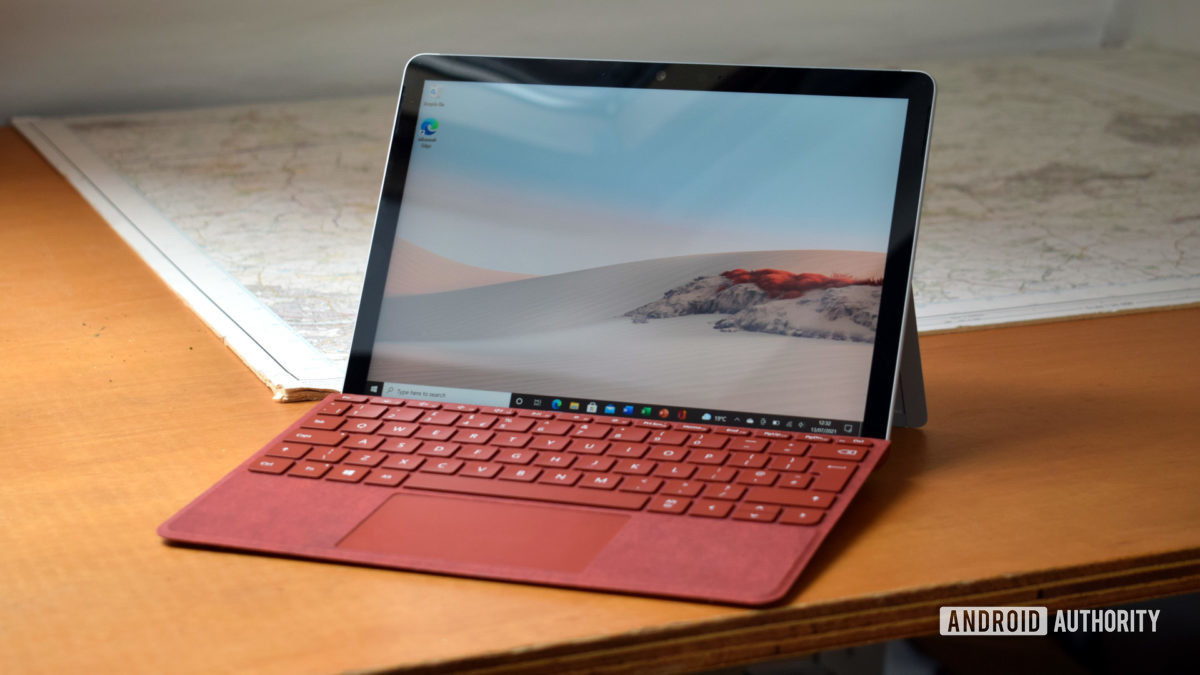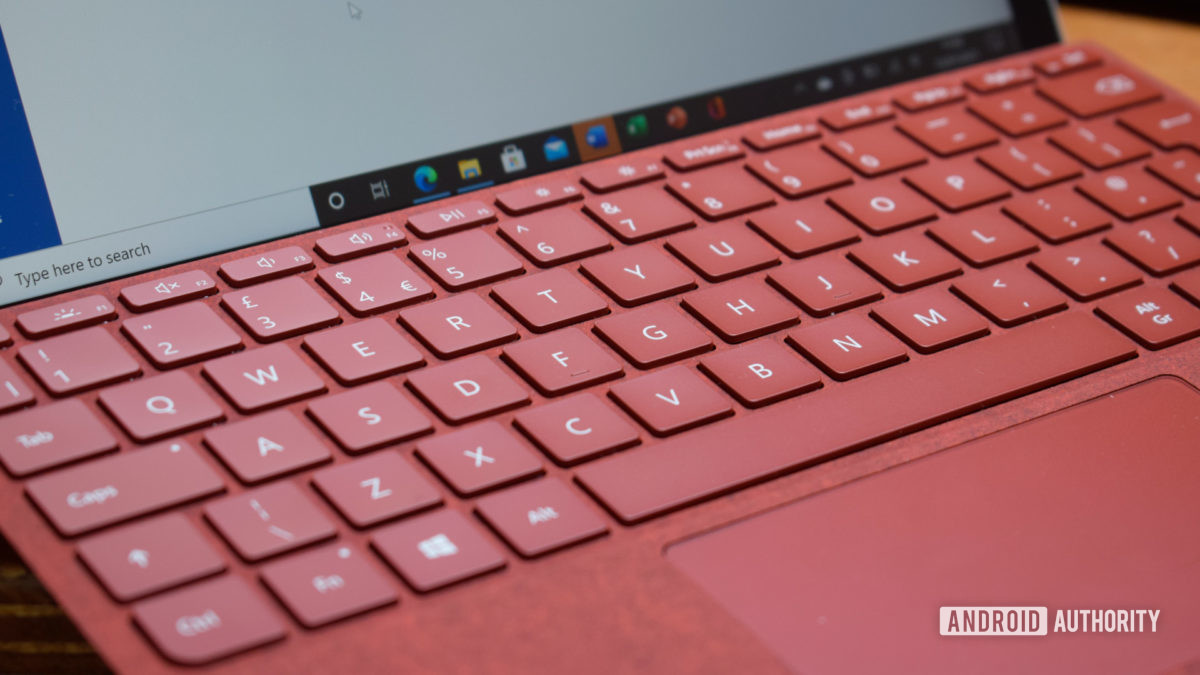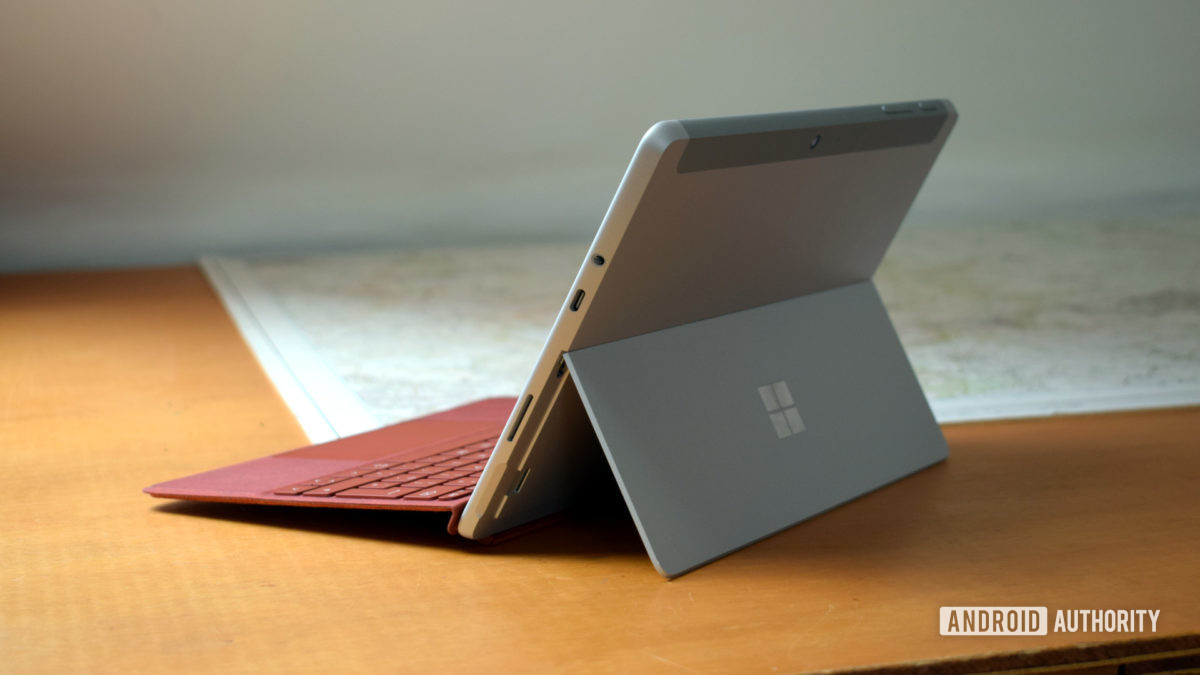The Surface Go 2 is Microsoft’s second-generation entry-level tablet, boasting Surface-level quality without the typically hefty price tag. But don’t let that fool you; Microsoft’s more affordable tablet still offers plenty of hardware to satisfy the more demanding tablet user. With Windows 10 onboard, the tablet also boasts access to some of the best office and creative tools in the business.
Read on for Android Authority’s Microsoft Surface Go 2 review and to see if it can make the cut as one of the best Windows tablets on the market.
What you need to know about the Microsoft Surface Go 2

- Surface Go 2 (Intel 4425Y, 4GB/64GB, Wi-Fi only): $399/£399/€459
- Surface Go 2 (Intel 4425Y, 8GB/128GB, Wi-Fi only): $549/£529/€485
- Surface Go 2 (Intel Core m3, 8GB/128GB, Wi-Fi only): $629/£619/€635
- Surface Go 2 (Intel Core m3, 8GB/128GB, 4G LTE): $729/£719/€750
The Surface Go 2 is Microsoft’s revamped affordable entry point into its Windows-powered tablet line-up. Upgrades over the original Surface Go include a larger display and a more powerful processing package. Like all of Microsoft’s Surface tablets, the Surface Go 2 comes with a sturdy, built-in kickstand. It was released in mid-May, 2020 and is available from the Microsoft Store, Amazon, and many other retailers.
See also: Android Authority’s guide to the best tablets
Core specifications offer a 10.5-inch display with 1,920 x 1,280 resolution and 3:2 aspect ratio, complete with Gorilla Glass 3 protection. The Microsoft Surface Go 2 comes with either a dual-core 1.7GHz Intel Pentium 4425Y or 3.4GHz Core m3 8100Y processor. Both pack the same Intel UHD Graphics 615, although the latter offers a marginally faster 900MHz compared to 850MHz clock speed. All but the cheapest model come with 8GB RAM and a 128GB SDD rather than 4GB RAM and 64GB of slower eMMC storage.
On the front, you’ll find a 5MP camera capable of 1080p video, flanked by a Windows Hello face authentication camera array. This allows for fast, secure tablet unlocking. There’s an 8MP camera on the back, complete with autofocus and 1080p video capabilities. The Surface Go 2 is bundled with a 24W Surface Connector charger in the box, but the tablet can also be charged over USB-C via USB Power Delivery at up to 45W.
Microsoft rounds out the feature set with Bluetooth 5.0, Wi-Fi 6, a headphone jack, ambient light sensor, microSDXC card reader, a dual-speaker and mic setup, and a USB-C port. There’s also firmware TMP onboard, an essential component for a free upgrade to Windows 11. The most expensive model includes 4G LTE bands for data on the go via physical SIM or eSIM.
Like its predecessor, the Surface Go 2 runs Windows 10 S Mode which limits you to downloading applications from the Microsoft Store and using the Edge browser. This can be upgraded to a full version of Windows, though this is a one-way deal. You can go back, but only by downloading the Recovery Image and factory resetting the device.
The Microsoft Surface Go 2 is available exclusively in a Platinum colorway. Your main customization options come from the Surface Go Type Cover. This is available for $129.99 in Ice Blue, Poppy Red (pictured), Platinum, and Black color options.
What’s good?

We tested the 8th Gen Intel Core m3 processor, 8GB RAM variant of the Surface Go 2, and performance is rock solid for word processing, multi-tab web browsing, and the like. Intel’s integrated mobile graphics supports an external 4K display I connected via USB-C without lag. Very handy for improving productivity versus the tablet’s small display. It’s also powerful enough to run some less demanding new titles and older games, such as The Elder Scrolls V: Skyrim, at playable frame rates, although this definitely isn’t a gaming-oriented device.
Unlocking the tablet using facial recognition is also blazingly fast. It feels even snappier than the first-gen premium-tier Surface Pro X I’ve been using for a while. The setup process is simple, and, as it’s based on infrared depth mapping, is far more secure than the basic face-unlock technology you’ll find on other laptops and smartphones.
On the subject of cameras, the front-facing webcam is great for video calls and the like. It offers a wide enough field of view and handles bright backlights and HDR environments well, so your calls won’t look washed out. However, you won’t find every video conferencing app on the Microsoft Store. See Zoom, for example.
The Surface Go 2 is a brilliant little tablet that’s powerful enough for work in a pinch.
While quite pricey, the Surface Go Type Cover is a nicely built keyboard/cover combination. Despite the thin profile, key travel is reasonable and the trackpad is very responsive. It feels like a necessary accessory for the tablet, as it vastly improves web browsing and document editing, while also offering screen protection when porting the tablet around. My only complaint is that the keys are a little sticky and loud. It’s definitely not a replacement for a sturdier office keyboard but serves its purpose well enough.
Read more: The best Android tablets you can buy
Overall, the Surface Go 2 is a brilliant little entertainment tablet with access to the best Windows applications. It’s powerful enough for work in a pinch as well.
What’s not so good?

Although the Surface Go 2 version I used comes with a 128GB SSD, only 73GB is actually free once you take into account the Windows OS and other pre-installed Microsoft apps. That’s not a lot of space for your own applications and media files. This storage limitation will be even tighter on the more affordable 64GB eMMC storage model. Although there’s the option to add in a microSD card for more storage, this format isn’t really suitable for apps.
Speaking of software, Windows 10 Home in S Mode is fine for basic use and can be removed at will, but it’s an irritating obstacle for installing your favorite games, multimedia, and even an alternative web browser. Microsoft shouldn’t be trying to insinuate that software downloaded from outside its ecosystem is inherently less safe. Also remember, you can’t go back to S Mode unless you factory reset the tablet.
See also: The best cheap Android tablets
I’m also not convinced by the tablet’s battery life. Microsoft advertises 10 hours of use, but this doesn’t seem achievable unless you go offline and turn the screen brightness right down. In reality, four to six hours of screen-on time is more realistic. That’s still solid enough battery life for lighter use cases, but this tablet doesn’t offer multi-day use and fades fast when you throw heavier workloads at it.
This so-so battery life might explain Microsoft’s decision to stick with a 60Hz refresh rate display. This specification is a little underwhelming compared to rival tablets like the iPad, which have adopted 120Hz panels. While fine in the cheaper model, I would have liked to see a higher refresh rate included with the Core m3 Surface Go 2.
Microsoft advertises 10 hours battery life, but four to six is more realistic.
Finally, pricing. While the base unit entry price is affordable, the Microsoft Surface Go 2 quickly becomes expensive once you add in the pretty much obligatory accessories. You’ll want the Surface Go Type Cover ($129) to make web browsing and document creation more practical on the go. Windows just isn’t well suited to a touch-only experience. At the very least the Surface Go Sleeve protective cover ($69) will help protect the display if you already have a Bluetooth keyboard and mouse ready to go. The Surface Pen ($99) is, thankfully, much more optional.
By the time you’ve added an accessory or two to your purchase, the Surface Go 2 could cost close to $1,000 at the high-end. As well-built as the Surface Go 2 is, it certainly shouldn’t command an ultra-premium price, so if you’re looking to spend that kind of money you’re better off looking at more premium alternatives.
Microsoft Surface Go 2 review: Should I buy it?

The Surface Go 2 is a fantastic little Windows tablet for entertainment and light workloads. The range offers a very affordable entry point into Microsoft’s Surface line-up and is one of the best value devices on the market right now. However, the costs quickly add up once you add the keyboard cover and Office software — and those who want to do more than surf the web will want to spring for the Core m3 model too. So the real cost of ownership probably starts at closer to the $700 mark. Fortunately, Microsoft offers an Essentials Bundle that works out a little cheaper than buying everything individually.
Microsoft’s Surface Go 2 isn’t the only powerful, portable Windows machine out there at that price. Alternatives include Lenovo’s 2-in-1 IdeaPad Flex 5 ($690) and HP’s Envy x360 series ($699). The 2-in-1 market is certainly the place to look if you need a sturdier keyboard for work and play. At the higher-end, Microsoft’s own more powerful Surface Pro 7 ($749) is a great machine, although it’s Wi-Fi only.
Related: Here are the best Microsoft Surface laptops and tablets
The Samsung Galaxy Tab S7 and S7 Plus ($529) are noteworthy tablet alternatives if you’re happy with an Android device. Prices range from $580/€599 up to $899/€879, not including the stylus or cover. That nets you a fancy 11-inch 120Hz LCD display, 256GB storage, decent Qualcomm Snapdragon 865 Plus processor, and optional 4G LTE connectivity. If you’re planning to spend money on the high-performance Surface Go 2, Apple’s 10.9-inch iPad Air ($599) fills a similar role in Apple’s ecosystem.
-
$539.97 at Microsoft
Save
$129
.00
Top Microsoft Surface Go 2 questions and answers
Q: Will the Surface Go 2 upgrade to Windows 11?
A: Yes. Microsoft states that the Surface Go 2 will be eligible for a free upgrade to Windows 11 in late 2021 or early 2022.
Q: Does the Surface Go 2 support 4G LTE?
A: Yes. The top-end model features a Nano-SIM tray with 4G LTE Advanced support. That model also sports an eSIM for use with compatible carriers.
Q: Does the Surface Go 2 support other Surface accessories?
A: The Surface Go 2 is compatible with the same accessories as the original Surface Go, including the Surface Go Type Cover, Surface Pen, Slim Pen, and Surface Dock 2.